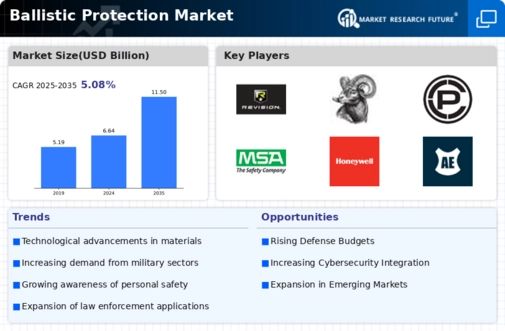Top Industry Leaders in the Ballistic Protection Market

Strategies Adopted:
Product Innovation: Key players focus on continuous innovation to develop lightweight, high-performance ballistic protection solutions that offer enhanced protection without compromising mobility and comfort.
Strategic Partnerships: Collaboration with defense agencies, research institutions, and technology providers enables companies to access cutting-edge technologies, expand their product portfolios, and strengthen their market position.
Market Diversification: Companies diversify their product offerings to cater to diverse end-user requirements across military, law enforcement, and commercial sectors, expanding their customer base and revenue streams.
Global Expansion: Strategic expansion into emerging markets and regions with high defense expenditure, such as Asia-Pacific and the Middle East, allows companies to capitalize on growing demand for ballistic protection solutions.
Factors for Market Share Analysis:
Technology Leadership: Market share analysis considers the technological capabilities and innovation prowess of key players, with companies offering state-of-the-art materials, designs, and manufacturing processes commanding a larger market share.
Product Portfolio: The breadth and depth of product portfolios, including body armor, helmets, vehicle armor, and ballistic plates, influence market share, with companies offering comprehensive solutions meeting diverse customer needs gaining a competitive edge.
Customer Relationships: Strong relationships with defense agencies, law enforcement organizations, and security agencies, built on reliability, performance, and after-sales support, contribute to market share by fostering loyalty and repeat business.
Brand Reputation: Brand reputation, built on quality, reliability, and customer satisfaction, plays a crucial role in market share analysis, with companies with a positive brand image enjoying higher market share and preference among end-users.
Industry News:
Advanced Materials Development: Industry news highlights advancements in lightweight materials, such as aramid fibers, ceramic composites, and ultra-high molecular weight polyethylene (UHMWPE), enhancing ballistic protection performance while reducing weight and bulk.
Contract Awards: News of contract awards and procurement programs by defense agencies and law enforcement organizations signify market leadership and bolster investor confidence in key players, driving market growth and expansion.
Technology Partnerships: Collaborations between key players and technology providers for the development of next-generation ballistic protection solutions, including smart textiles, nanomaterials, and additive manufacturing, drive innovation and competitiveness in the market.
Regulatory Updates: Updates on regulations, standards, and testing protocols for ballistic protection equipment impact market dynamics, with companies adapting their products and manufacturing processes to ensure compliance and meet evolving requirements.
Current Company Investment Trends:
R&D Investments: Continued investments in research and development drive innovation in ballistic protection solutions, with companies focusing on lightweight materials, advanced manufacturing techniques, and integrated sensor technologies to enhance performance and survivability.
Mergers and Acquisitions: Key players pursue mergers and acquisitions to strengthen their market position, expand their product portfolios, and gain access to new technologies and capabilities, driving consolidation and market consolidation in the ballistic protection market.
Global Market Expansion: Companies invest in global market expansion strategies, including establishing regional offices, distribution networks, and manufacturing facilities in key growth markets to capitalize on emerging opportunities and strengthen their competitive position.
Sustainability Initiatives: Increasing focus on sustainability initiatives, such as eco-friendly materials, energy-efficient manufacturing processes, and recycling programs, aligns with customer preferences and regulatory requirements, driving market differentiation and brand value.






